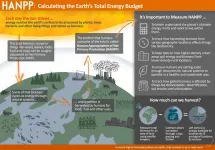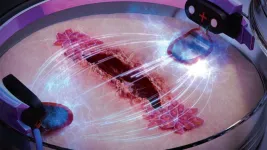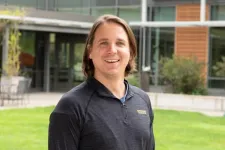(Press-News.org) AI software can accurately detect TB from chest X-rays, a study being presented at this year’s European Congress of Clinical Microbiology & Infectious Diseases (ECCMID) in Copenhagen, Denmark, (15-18 April), shows.
Tuberculosis (TB) is a major cause of death and disease worldwide. It causes 1.6 million deaths a year, making it is the 13th leading cause of death globally and the second biggest infectious killer, after COVID-19.
In low-resource settings, chest X-rays play an important role in the diagnosis of patients unable to produce good quality sputum samples for microbiological analysis. Computer-aided detection (the use of software to analyse X-rays for abnormalities) could assist in diagnosis in areas with a lack of radiologists.
However, there is a lack of good quality studies assessing its diagnostic accuracy, as highlighted recently by the World Health Organisation.1
To find out more, Dr Frauke Rudolf, of the Department of Infectious Diseases, Aarhus University Hospital, Aarhus, Denmark, and colleagues compared the performance of artifical intelligence (AI) software (qXR, Qure.ai, Mumbay, India) in assessing chest X-rays with that of two Ethiopian radiologists with different levels of experience.
To improve applicability in low resource settings, the AI was given mobile phone photographs of analogue (non-digital) CXRs.
Chest X-rays from 498 patients were analysed retrospectively. Fifty-seven (11%) of these patients had been diagnosed with TB, 41 clinically and 16 through PCR tests (Xpert MTB/Rif).
The AI software was as good or better than a trained radiologist at identifying the PCR-confirmed cases. It correctly identified 75% of all PCR-confirmed cases (sensitivity of 75%) and 85.7% of non-TB cases (specificity of 85.7%).
The less experienced radiologist’s assessments had a sensitivity of 62.5% (they correctly picked up 62.5% of the PCR-confirmed cases) and a specificity of 91.7% (they correctly identified 91.7% of those who didn’t have TB).
The experienced radiologist’s assessments were 75% sensitive and 82.0% specific.
The agreement in results between the radiologists was moderate, as was the agreement between the radiologists combined and the software.
Dr Rudolf says: “With an estimated 3 million undiagnosed patients in 2021, there is an urgent need to develop novel strategies and technologies aimed at improving TB detection in low-resource, high-incidence settings.
“We’ve shown that AI software is at least as good at detecting TB as a trained radiologist and that a simple mobile phone photograph is sufficient for analysis.
“In low resource areas with a high incidence of TB but a shortage of radiologists, chest X-rays could be photographed with a mobile phone and the image sent be analysed remotely by the AI.
“This would allow more chest X-rays to be read properly and, crucially, allow more cases of TB to be diagnosed.”
Dr Frauke Rudolf, Department of Infectious Diseases, Aarhus University Hospital, Aarhus, Denmark T) +45 513 72359 E) frauke.rudolf@au.dk
Alternative contact: Tony Kirby in the ECCMID Media Centre. T) +44 7834 385827 E) tony@tonykirby.com
Notes to editors:
References:
1. WHO. Chest radiography in tuberculosis detection: summary of current WHO recommendations and guidance on programmatic approaches. 2016. p. WHO/HTM/TB/2016.20. https://apps.who.int/iris/handle/10665/252424
The authors declare no conflicts of interest.
This press release is based on oral presentation 3073 at the European Congress of Clinical Microbiology & Infectious Diseases (ECCMID) annual meeting. The material has been peer reviewed by the congress selection committee. There is no full paper at this stage and, as it is an oral presentation, there is no poster.
END
AI software at least as good as radiologists at detecting TB from chest X-rays
2023-04-18
ELSE PRESS RELEASES FROM THIS DATE:
Targeting nurse and patient ‘supercontactors’ in hospitals and long-term care facilities can help minimize spread of infectious diseases
2023-04-18
New research presented at this week’s European Congress of Clinical Microbiology & Infectious Diseases (Copenhagen, 15-18 April) shows how interventions focused on so called ‘supercontactors’ in hospitals and other long term care facilities (LTCF) can optimise infection control and reduce the spread of infectious diseases. The study is by Dr Quentin Leclerc and colleagues at Institut Pasteur and the Conservatoire National des Arts et Métiers (Paris, France).
Hospitals and ...
Using machine learning to find reliable and low-cost solar cells
2023-04-18
Researchers at the University of California, Davis College of Engineering are using machine learning to identify new materials for high-efficiency solar cells. Using high-throughput experiments and machine learning-based algorithms, they have found it is possible to forecast the materials’ dynamic behavior with very high accuracy, without the need to perform as many experiments.
The work is featured on the cover of the April issue of ACS Energy Letters.
Hybrid perovskites are organic-inorganic molecules that have received a lot of attention ...
Resident T-cells key to salmonella immunity
2023-04-18
Salmonella infections cause about a million deaths a year worldwide, and there is an urgent need for better vaccines for both typhoid fever and non-typhoidal Salmonella disease. New work from researchers at the UC Davis School of Veterinary Medicine shows how memory T cells, crucial for a vaccine that induces a powerful immune response, can be recruited into the liver in a mouse model of Salmonella.
The work was published April 11 in Proceedings of the National Academy of Sciences.
“Understanding the immunology is key to developing a better vaccine,” said Professor Stephen McSorley, ...
Counting the cost of sunshine: Finding a better metric to measure human ecological footprints
2023-04-18
This planet of 8 billion people is bumping up against its ecological limits, and researchers are trying to quantify the effect of human activity on these finite resources. Some keep tallies of how much carbon they contribute to the atmosphere, others measure direct and indirect water consumption or keep tabs on the amount of land that our food habits demand.
Each of these “footprints” offers an estimate of the impacts individuals and institutions have on the wider world, and are useful — but are flawed, according to geographer Chris ...
School discipline can be predicted, new research says. Is it preventable?
2023-04-18
Berkeley — Rates of school discipline fluctuate widely and predictably throughout a school year and increase significantly faster for Black students than for their white counterparts, University of California, Berkeley, researchers have found.
A new study published today in the journal Proceedings of the National Academy of Sciences documents for the first time the “dynamic” nature of student discipline during an academic year. Daily rates of punishment across all schools in the study ratchet up in the weeks before Thanksgiving break, decline immediately ...
How electricity can heal wounds three times as fast
2023-04-18
Chronic wounds are a major health problem for diabetic patients and the elderly – in extreme cases they can even lead to amputation. Using electric stimulation, researchers in a project at Chalmers University of Technology, Sweden, and the University of Freiburg, Germany, have developed a method that speeds up the healing process, making wounds heal three times faster.
There is an old Swedish saying that one should never neglect a small wound or a friend in need. For most people, a small wound does not lead to any serious complications, but many common diagnoses ...
Orb weaver spider glue properties evolve faster than their glue genes, scientists find
2023-04-18
Spiders that don’t weave good silk don’t get to eat. The silk spiders produce which creates their webs is key to their survival – but spiders live in many different places which require webs fine-tuned for local success. Scientists studied the glue that makes orb weaver spiders’ webs sticky to understand how its material properties vary in different conditions.
“Discovering the sticky protein components of biological glues opens the doors to determining how material properties evolve,” said Dr Nadia Ayoub of Washington and Lee University, co-corresponding author of the study ...
Machine learning can help to flag risky messages on Instagram while preserving users’ privacy
2023-04-17
As regulators and providers grapple with the dual challenges of protecting younger social media users from harassment and bullying, while also taking steps to safeguard their privacy, a team of researchers from four leading universities has proposed a way to use machine learning technology to flag risky conversations on Instagram without having to eavesdrop on them. The discovery could open opportunities for platforms and parents to protect vulnerable, younger users, while preserving their privacy.
The team, led by researchers from Drexel University, Boston University, Georgia Institute of Technology ...
TOP advisory board welcomes new chair and members
2023-04-17
Charlottesville, VA – The Transparency and Openness Promotion (TOP) Guidelines Advisory Board welcomes its new chair, Sean Grant, and board members to support its mission to promote transparency across the research lifecycle.
Grant is a Research Associate Professor at the HEDCO Institute for Evidence-Based Educational Practice at the University of Oregon with extensive experience researching TOP as Co-Principal Investigator for Transparency of Research Underpinning Social Intervention ...
UC Irvine physicists discover first transformable nano-scale electronic devices
2023-04-17
Irvine, Calif., April 17, 2023 — The nano-scale electronic parts in devices like smartphones are solid, static objects that once designed and built cannot transform into anything else. But University of California, Irvine physicists have reported the discovery of nano-scale devices that can transform into many different shapes and sizes even though they exist in solid states.
It’s a finding that could fundamentally change the nature of electronic devices, as well as the way scientists research atomic-scale quantum materials. The study is published ...



